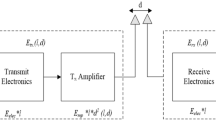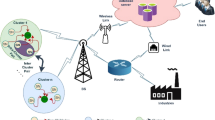Abstract
Wireless sensor networks have become a vital part of the Internet of Things (IoT) applications. Due to its resource constraints nature, significant challenges in achieving QoS requirements include optimal energy utilization, enhanced lifespan, minimum delay, adequate packet delivery ratio, etc. Many optimizations and routing methods to solve these issues have been discussed in recent literature. However, they have limitations when dealing with high-dimensional data with complex latent distributions. Thus, In this article, we propose an energy-aware neuro-fuzzy routing model (EANFR) that deals with the high-energy sensor nodes to form the clusters and make routing decisions in a feature space generated by a deep neural network to solve the problem. The trained EANFR model can select appropriate cluster head nodes and routes over the most energized, shortest path. A systematic and comprehensive simulation was carried out, and the statistical analysis results show that the proposed EANFR model acquired the lowest training errors. Furthermore, the EANFR outperforms recent literature in terms of network lifetime, particularly on energy-aware clustering using neuro-fuzzy approach by 89.23%, Adaptive Q Learning by 67.21%, and Radial Basis Fuzzy Neural Network Type 2 Fuzzy Weights by 20.63%. According to this research study, the proposed EANFR model significantly improves the network lifespan and QoS performances of WSN making it suitable for IoT monitoring applications.











Similar content being viewed by others
Data availability
Data sharing is not applicable to this article as no datasets were generated or analyzed during the current study.
References
Chandnani, N., & Khairnar, C. N. (2022). Bio-inspired multilevel security protocol for data aggregation and routing in IoT WSNs. Mobile Networks and Applications, 18, 1–20.
Kumar, P., & Reddy, S. R. (2020). Wireless sensor networks: A review of motes, wireless technologies, routing algorithms and static deployment strategies for agriculture applications. CSI Transactions on ICT, 8(3), 331–45.
Mahbub, M. (2022). IoT ecosystem: Functioning framework, hierarchy of knowledge, and intelligence. In Artificial intelligence-based internet of things systems (pp. 47–76). Springer.
Ge, X., Han, Q. L., Zhang, X. M., Ding, L., & Yang, F. (2019). Distributed event-triggered estimation over sensor networks: A survey. IEEE Transactions on Cybernetics, 50(3), 1306–20.
Choubey, D. K., Shukla, V., Soni, V., Kumar, J., & Dheer, D. K. (2022). A review on IoT architectures, protocols, security, and applications. In Industrial Internet of Things (pp. 225–242). CRC Press.
Gong, D., & Yang, Y. (2014). Low-latency SINR-based data gathering in wireless sensor networks. IEEE Transactions on Wireless Communications, 13(6), 3207–21.
Ye, D., & Zhang, M. (2017). A self-adaptive sleep/wake-up scheduling approach for wireless sensor networks. IEEE Transactions on Cybernetics, 48(3), 979–92.
Harb, H., & Makhoul, A. (2017). Energy-efficient sensor data collection approach for industrial process monitoring. IEEE Transactions on Industrial Informatics, 14(2), 661–72.
Misra, S., & Kumar, N. (2022) Special issue on artificial intelligence, edge, and Internet of Things for smart agriculture. IEEE Micro, 42(01), 6–7.
Kibria, M. G., Nguyen, K., Villardi, G. P., Zhao, O., Ishizu, K., & Kojima, F. (2018). Big data analytics, machine learning, and artificial intelligence in next-generation wireless networks. IEEE Access, 17(6), 32328–38.
Kumar, V., Kumar, V., Sandeep, D. N., Yadav, S., Barik, R. K., Tripathi, R., & Tiwari, S. (2018). Multi-hop communication based optimal clustering in hexagon and voronoi cell structured WSNs. AEU-International Journal of Electronics and Communications, 1(93), 305–16.
Song, L., Chai, K. K., Chen, Y., Schormans, J., Loo, J., & Vinel, A. (2017). QoS-aware energy-efficient cooperative scheme for cluster-based IoT systems. IEEE Systems Journal, 11(3), 1447–55.
Seema, B., Yao, N., Carie, A., & Shah, S. B. (2020). Efficient data transfer in clustered IoT network with cooperative member nodes. Multimedia Tools and Applications, 79(45), 34241–51.
Raj, J. S., & Basar, A. (2019). QoS optimization of energy efficient routing in IoT wireless sensor networks. Journal of ISMAC, 1(01), 12–23.
Thangaramya, K., Kulothungan, K., Logambigai, R., Selvi, M., Ganapathy, S., & Kannan, A. (2019). Energy aware cluster and neuro-fuzzy based routing algorithm for wireless sensor networks in IoT. Computer Networks, 14(151), 211–23.
Huang, J., Ruan, D., & Meng, W. (2018). An annulus sector grid aided energy-efficient multi-hop routing protocol for wireless sensor networks. Computer Networks, 24(147), 38–48.
Kong, L., Pan, J. S., Snášel, V., Tsai, P. W., & Sung, T. W. (2018). An energy-aware routing protocol for wireless sensor network based on genetic algorithm. Telecommunication Systems, 67(3), 451–63.
Toor, A. S., & Jain, A. K. (2019). Energy aware cluster based multi-hop energy efficient routing protocol using multiple mobile nodes (MEACBM) in wireless sensor networks. AEU-International Journal of Electronics and Communications, 1(102), 41–53.
Harold Robinson, Y., Golden Julie, E., Balaji, S., & Ayyasamy, A. (2017). Energy aware clustering scheme in wireless sensor network using neuro-fuzzy approach. Wireless Personal Communications, 95(2), 703–21.
Thangaramya, K., Kulothungan, K., Logambigai, R., Selvi, M., Ganapathy, S., & Kannan, A. (2019). Energy aware cluster and neuro-fuzzy based routing algorithm for wireless sensor networks in IoT. Computer Networks, 14(151), 211–23.
Alarifi, A., & Tolba, A. (2019). Optimizing the network energy of cloud assisted internet of things by using the adaptive neural learning approach in wireless sensor networks. Computers in Industry, 1(106), 133–41.
Jazebi, S. J., & Ghaffari, A. (2020). RISA: Routing scheme for Internet of Things using shuffled frog leaping optimization algorithm. Journal of Ambient Intelligence and Humanized Computing, 11(10), 4273–83.
Pattnaik, S., & Sahu, P. K. (2020). Assimilation of fuzzy clustering approach and EHO-Greedy algorithm for efficient routing in WSN. International Journal of Communication Systems, 33(8), e4354.
Sahoo, B. M., Pandey, H. M., & Amgoth, T. (2021). GAPSO-H: A hybrid approach towards optimizing the cluster based routing in wireless sensor network. Swarm and Evolutionary Computation, 1(60), 100772.
Rajput, A., & Kumaravelu, V. B. (2021). FCM clustering and FLS based CH selection to enhance sustainability of wireless sensor networks for environmental monitoring applications. Journal of Ambient Intelligence and Humanized Computing, 12(1), 1139–59.
Yarinezhad, R., & Azizi, S. (2021). An energy-efficient routing protocol for the Internet of Things networks based on geographical location and link quality. Computer Networks, 5(193), 108116.
Varun, R. K., Gangwar, R. C., Kaiwartya, O., & Aggarwal, G. (2021). Energy-efficient routing using fuzzy neural network in wireless sensor networks. Wireless Communications and Mobile Computing, 10, 2021.
Chithaluru, P., Kumar, S., Singh, A., Benslimane, A., & Jangir, S. K. (2021). An energy-efficient routing scheduling based on fuzzy ranking scheme for Internet of Things. IEEE Internet of Things Journal, 9(10), 7251–60.
Rasi, D., & Deepa, S. N. (2021). Energy optimization of internet of things in wireless sensor network models using type-2 fuzzy neural systems. International Journal of Communication Systems, 34(17), e4967.
Babu, M. V., Alzubi, J. A., Sekaran, R., Patan, R., Ramachandran, M., & Gupta, D. (2021). An improved IDAF-FIT clustering based ASLPP-RR routing with secure data aggregation in wireless sensor network. Mobile Networks and Applications, 26(3), 1059–67.
Fanian, F., & Rafsanjani, M. K. (2019). Cluster-based routing protocols in wireless sensor networks: A survey based on methodology. Journal of Network and Computer Applications, 15(142), 111–42.
Behera, T. M., Samal, U. C., & Mohapatra, S. K. (2018). Energy-efficient modified LEACH protocol for IoT application. IET Wireless Sensor Systems, 8(5), 223–8.
Su, S., & Zhao, S. (2018). An optimal clustering mechanism based on Fuzzy-C means for wireless sensor networks. Sustainable Computing: Informatics and Systems, 1(18), 127–34.
Jang, J. S. (1993). ANFIS: Adaptive-network-based fuzzy inference system. IEEE Transactions on Systems, Man, and Cybernetics, 23(3), 665–85.
Kumar, S., Lal, N., & Chaurasiya, V. K. (2018). A forwarding strategy based on ANFIS in internet-of-things-oriented wireless sensor network (WSN) using a novel fuzzy-based cluster head protocol. Annals of Telecommunications, 73(9), 627–38.
Wang, L. X. (1992). Fuzzy systems are universal approximators. In [1992 Proceedings] IEEE international conference on fuzzy systems (pp. 1163–1170). IEEE.
Li, H. X., & Liu, Z. (2008). A probabilistic neural-fuzzy learning system for stochastic modeling. IEEE Transactions on Fuzzy Systems, 16(4), 898–908.
Guzel, M., Kok, I., Akay, D., & Ozdemir, S. (2020). ANFIS and Deep Learning based missing sensor data prediction in IoT. Concurrency and Computation: Practice and Experience, 32(2), e5400.
Chadha, J., Jain, A., & Kumar, Y. (2022). Artificial intelligence techniques in wireless sensor networks for accurate localization of user in floor, building and indoor area. Multimedia Tools and Applications, 8, 1–34.
Funding
The authors declare that no funds, grants, or other support were received during the preparation of this manuscript.
Author information
Authors and Affiliations
Contributions
All authors contributed to the study conception and design. Methodology, Software, analysis and original draft preparation were performed by SJ. The final draft of the manuscript was supervised, reviewed and edited by BR. Both the authors read and approved the final manuscript.
Corresponding author
Ethics declarations
Conflict of interest
The authors have no relevant financial or non-financial interests to disclose.
Additional information
Publisher's Note
Springer Nature remains neutral with regard to jurisdictional claims in published maps and institutional affiliations.
Rights and permissions
Springer Nature or its licensor holds exclusive rights to this article under a publishing agreement with the author(s) or other rightsholder(s); author self-archiving of the accepted manuscript version of this article is solely governed by the terms of such publishing agreement and applicable law.
About this article
Cite this article
Jeevanantham, S., Rebekka, B. Energy-aware neuro-fuzzy routing model for WSN based-IoT. Telecommun Syst 81, 441–459 (2022). https://doi.org/10.1007/s11235-022-00955-6
Accepted:
Published:
Issue Date:
DOI: https://doi.org/10.1007/s11235-022-00955-6




